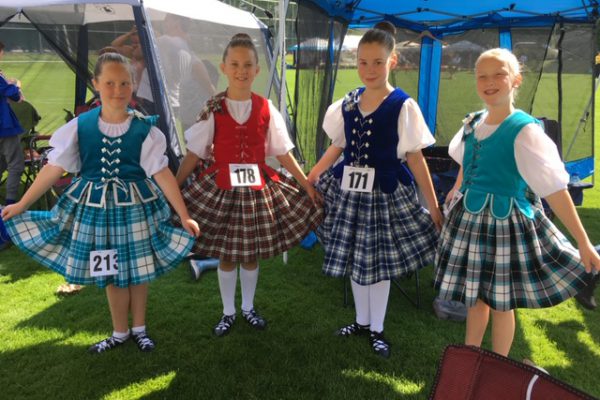Drums beat, waves pound, lungs gasp for breath, feet hammer the floor, voices whisper and cry out. These are the sounds of dance Immersion’s latest showcase production, Footsteps Across Canada.
The mixed bill celebrated the cultural diversity of both Canadian dance and the African diaspora. Six choreographers from Ontario, Alberta, Montréal and Nova Scotia took to the stage with dynamic energy and emotional force. Each work was intensely personal, sometimes painfully so. While the choreographic work varied drastically from one piece to the next, universal themes of loss, tradition, internal struggle, displacement and the challenges posed by communication wove the dances together.
The program began with two solos — first BOW’T by dancer/choreographer Rhodnie Désir (Montréal), then Tide from dancer/choreographer Liliona Quarmyne (Nova Scotia). BOW’T (a play on the word boat) evokes stories of migration — both forced and voluntary. Musician Ronald Nazaire provided percussive accompaniment, listening and pausing in a sensitive response to Désir’s dancing.
Both Nazaire and Désir wear striking red-and-white costumes, a colour scheme that is mirrored in the decor with red-and-white paper boats arranged in clusters on the floor. Désir’s choreography offers fragmented images of travel and confinement alongside dramatic shaking movements and startlingly light and fast footwork. A muscular, powerful performer, Désir has a commanding stage presence.
Tide dovetailed beautifully, exploring similar themes to BOW’T with a projected video of the ocean as its backdrop. Quarmyne hides and reveals her body — wrapping herself in one long piece of white fabric. Tide encompasses both loss and joy, which Quarmyne’s expressive face makes clear. The highlight of the solo lay in the complex and subtle imagery of the fabric, which transformed Quarmyne from an ocean wave to a ghost, a bride and even a corpse beneath a sheet.
Both Tide and BOW’T manipulate imagery of the sea to uncover contrasting metaphors for displacement, loss, freedom and powerlessness.
Rodney Diverlus’ choreographic work was a fresh voice on the stage. After two solos, the quartet two to see, four to reason offered contrast with a more energetic, upbeat pace. Diverlus’ work is a reflection on conversations — those we leave incomplete and those we wish we could change. Diverlus is Haitian-Canadian and a recent graduate of Ryerson University’s Dance Program. His current engagement as a dancer with Calgary’s Decidedly Jazz Danceworks seemed to flavour his choreographic choices. Grounded contemporary phrases, momentum-driven movement and partner work encountered jazz rhythms, footwork, syncopation and understated stylistic flair. Diverlus successfully balanced repetition of movement motifs with the development of choreographic themes; the elegantly executed dance phrases were a high point in the mixed program.
Songs of the Soil is a turbulent and disorienting mixture of images, sound and movement by South African performer Mafa Makhubalo. The work features sound recordings from an interview with anti-apartheid activist Steve Biko and from a traditional healer’s ceremony. Makhubalo crawls onto the stage, pulling on a chain that attaches his neck to a book. He performs undulating, percussive and muscular dance sequences as he sings and rips pages out of the book. Songs of the Soil seemed to enact a journey from enslavement to education and enlightenment; however, the solo left perplexing impressions. Its coded symbolism was hard to interpret — the chain and book, a tie he wore, a fan he used and the pictures projected behind him on screen. No clues were left in the program description. However, Makhubalo’s intensity and commitment as a performer were impressive and his charged performance certainly merits note.
Esie Mensah’s The Debate was an audience favourite, receiving loud cheers and thunderous applause. An impressive trio of dancers — Percy Anane-Dwumfour, Lauren Lyn and Daniel Gomez — deftly performed a theatrical monologue with energetic Afro-house and contemporary partnering. An excerpt of a longer piece (Akoma), the trio stood alone as a coherent work. In The Debate a man recounts his journey from Ghana to Canada, sharing the struggle of displacement and identity formation. His thoughts come to life and are embodied by the other two dancers. While this may seem a choreographic cliché, it was nevertheless full of emotional resonance. The work was joyful, intense, passionate, angry and funny; the dancers seamlessly made their way through these emotional stages with grace and ease.
The final piece in the program, DICHOTOMY, was a compelling solo created and performed by Mikhail Morris. Morris elevates dancehall to a form of art beyond its representation in both pop culture and the entertainment industry. The imagery in this work was spectacular, beginning when Morris emerges from the shadows into a pool of light, reaching through the ropes of his braided hair to reveal a black mask. He was demonic and human, possessed by contrasting energies in a manner that seemed almost shamanistic. In a startling reveal, Morris exhales clouds of smoke that hover in the space around him. The imagery in this dark, haunting work resonated long after the piece ended.
In sum, Footsteps Across Canada presented absorbing work by six dynamic choreographers. While the program varied, these works were united in their desire to question identities and reveal the human spirit. Each choreographer explored a fusion of jazz, Afro-house, contemporary and dancehall, all within the context of the African diaspora. The program revealed a slice of Canada’s vast geographic and ethnic landscape. It was a meditation on the personal journeys taken across this land and the wide world as humans search to find their identity and their home.
Tagged: African, Choreography, Contemporary, Esie Mensah, Performance, ON , Toronto





